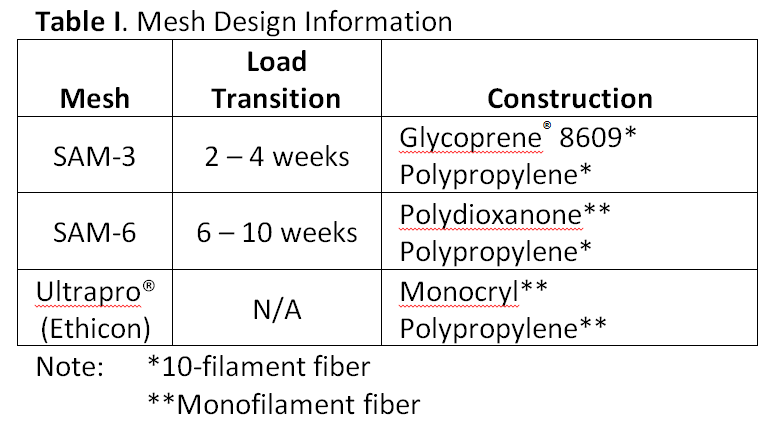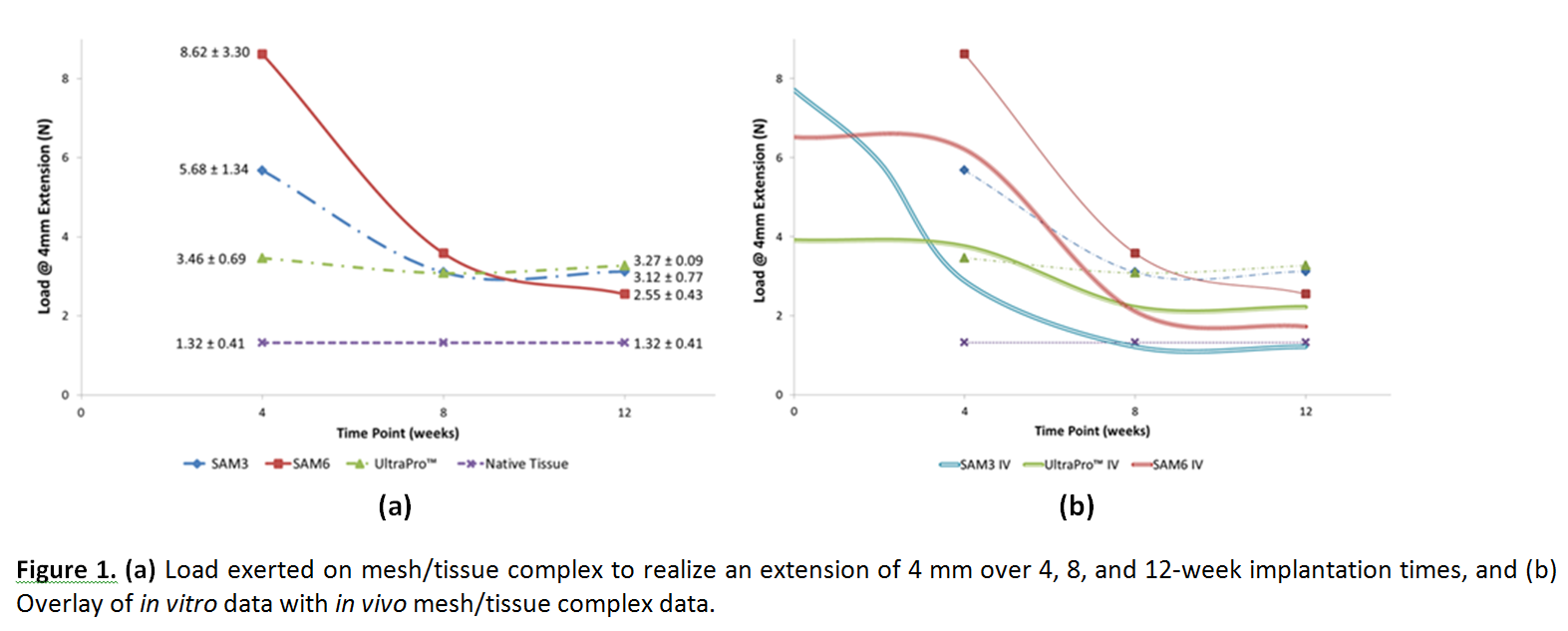Statement of Purpose: Hernia repair is one of the most frequently performed surgical operations in the US with approximately 800,000 procedures performed annually[1]. The vast majority of these repairs employ a “tension-free” repair technique which involves the use of synthetic surgical meshes that remain mechanical stiff for the lifetime of the patient. Although these procedures appear to have reduced the frequency of recurrence, they have led to the introduction of several long-term complications. This includes chronic pain, increased abdominal wall stiffness, fibrosis, and mesh contraction[2]. The present study examines the in vivo performance of a novel selectively absorbable mesh construction that exhibits early mechanical stability that ultimately transitions to a level of increased mechanical extensibility and compliance over time as the absorbable portion of this device loses strength, thus allowing mechanical sharing of loads between the deposited tissue and the implanted mesh, which is theorized to reduce long term complications
Methods: Two selectively absorbable mesh (SAM) constructs were evaluated along with a partially absorbable predicate material, as described in Table I. A total of 27 New Zealand White female rabbits were used to create a chronic ventral hernia, as described previously[3], where an initial defect was created and allowed to form a mature hernia. Repair consisted of dissecting the hernia sack. The hernia was repaired using either SAM-3, SAM-6, or UltraPro® Mesh (Ethicon) with an intraperitoneal repair technique and secured in place with 4-O PDS™ II Suture (Ethicon), followed by skin closure with 3-O PDS™ II suture and a light application of an absorbable tissue adhesive, Tissumend II (VPL). At 4, 8, and 12 weeks post-repair, animals were euthanized and the mesh/tissue complex was harvested for mechanical testing using a custom burst frame, consisting of a 2 cm diameter tissue fixture and a 1.4 cm rounded and polished pin. Mechanical evaluation was conducted on an MTS Synergie load frame at a rate of 13cm/min following a 0.1 N pre-load to a maximum extension of 4 mm. The resulting load/extension plot was analyzed and compared to in vitro-aged mesh tested under the same conditions.

Results and Discussion: In this test scenario, a higher force is indicative of a less compliant mesh/tissue complex. Mechanical data, as shown in Figure 1, indicate that SAM-6 and SAM-3 mesh resulted in a significantly less compliant repair as compared to UltraPro™ 4 weeks post-surgery. However, the compliance of the repair for these developed constructions transitioned over time as the absorbable component lost strength, resulting in a more compliant terminal construction. While UltraPro™ undergoes similar mass loss due to absorption, mechanics of the hernia repair remain essentially unchanged. Furthermore, SAM-6 resulted in a significantly more compliant repair at 12 weeks compared to both UltraPro® and SAM-3, possibly due to the incorporation of a monofilament PDO material.

Conclusion: The design intent of the developed SAM constructions was to create a mesh that initially protects the hernia repair site while gradually transitioning to a more compliant construction over time to allow for improved collagen remodeling for improved overall repair site mobility. While these constructions resulted in a stiffer repair initially, the mesh and repair site transitioned to increased compliance over a 12-week period. Such a construction has the potential to improve repair mobility and reduce related clinical complications in mesh hernioplasty.
This work was supported by NIH Grant 1R43GM112194-01; The authors would like to thank Dr. John Parrish and Travis Pruitt at Godley-Snell Research Center, Clemson University for their assistance with this project
References:
[1] Rutkow, I.M. Surg Clin North Am. 83(5), 1045 (2003)
[2] Amid, P.K, et al. J Am Coll Surg. 205(2), 381 – 385 (2007)
[3] Hilas, G.T., et al. Trans Soc. Biomater., 2015